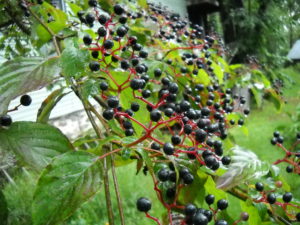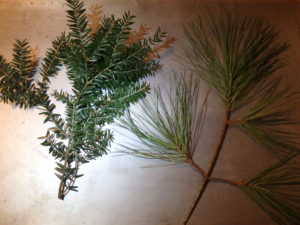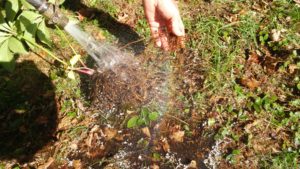Planting For the Birds
I’ve never calculated how much I spend each year on bird seed, but it’s considerable. I know people some spend a lot more, who think nothing of buying big bags of 2 or 3 kinds of specialized seeds for the birds every few weeks, and who maintain half a dozen feeders much of the year.
Does Mother Nature buy bags of booty for birds? No. We can reduce our expenditures and help the birds through judicious management of our wild spaces and our gardens. Now is a good time to plant a few things for the birds.
To support birds, it’s important to provide them with food all year, nesting places, and safe places out of the reach of cats, foxes and hawks. Agreed, it is easier to feed black oil sunflower seeds to provide food in winter than to plant trees, but there are trees and shrubs that do provide fall and winter food.
Shrubs are great for summer and fall treats. Pagoda dogwood (Cornus alternifolia) provides berries that are eaten voraciously in mid-August, but are long gone now. Same for blueberries, which, alas, are enjoyed by the birds as much as they are by us.
Three shrubs that produce fall berries are silky dogwood (Cornus amomum), red osier dogwood (Cornus sericea) and gray dogwood (Cornus racemosa). The first two grow wild in wet areas in part shade to full sun. Gray dogwood appears at the edges of dry forests. All produce berries enjoyed by birds. I went out in early October and found just a few berries left on silky dogwood growing wild near my stream. All have berries from August to October.
For winter food, nuts and cones are the best source of bird food. It’s true that most birds cannot break open a walnut, chestnut or acorn – though I have seen crows feeding on walnuts broken open on the road. But as the winter progresses, nuts soften and the interiors become available to birds. Squirrels are messy eaters, and often leave parts of nuts scattered on the ground and available to birds, too.
Two of the most popular trees with birds are the white pine and Canadian hemlock. Not only do they provide food – seeds from their cones – they provide shelter and nesting places. The eastern white pine is used by more than 40 species of birds, and Canadian hemlock is used by more than 25 species.
If you are interested in learning more about trees and shrubs used by birds, I highly recommend a book by Richard M. DeGraaf, Trees, Shrubs and Vines for Attracting Birds (University Press of New England, 2nd edition, paperback at $24.95). This book lists, for each common species of woody plant, the birds that use it, and how they use it.
Is this a good time to plant trees and shrubs? Yes. Actually there are two schools of thought about this. Scientists have determined that trees and shrubs extend their roots in the fall, even after leaf drop. So many plantsmen, myself included, vote for fall planting. Not only are roots going to grow, the climate is usually cooler and wetter, so the chances of drying out are smaller.
The other school of thought maintains that planting in spring is better. They say that so long as you are attentive to your plants, and keep them watered, they have more time to get settled in before the stress of winter. I’m a careful gardener, but a busy person, and I know how easy it is to forget about watering for a week or two – which in august can be deadly. So I say plant now – or in September, but not after early November.
I recently went to a gardening workshop where one of the presenters advocated removing much of the soil from perennials purchased in pots before planting. The idea is that plants grown in pots get their roots all snarled up over time, and have roots circling the plants. I have always teased out plant roots with a finger or a tool, but have never used her suggestion – a stream of water.
So recently I tried using the hose to loosen plant roots, and, much to my surprise, it worked very well. I thought I’d be holding a handful of mud and a disintegrating root ball, but it worked fine. So next time I plant a tree or shrub, I shall try using a sharp stream of water to wash away some of the soil and to allow me to tease out the roots more easily – without breaking them.
But back to the birds. Here is a list of plants that DeGraaf’s book list as helping 20 or more species of birds: balsam fir, sugar maple, serviceberry (Amelanchier spp.), birches, flowering dogwood (Cornus florida), beech, Eastern red cedar, apples and crabapples, red mulberry, black tupelo, spruces, pitch pine, cherries of all kinds, oaks and American elm. That list includes some Zone 5 and 6 trees, so not all are appropriate everywhere.
Of the shrubs, here are some of the best: dogwoods of all kinds, hawthorn, huckleberry, bayberry, staghorn sumac, roses, brambles of all sorts, elders and blueberries. Common grapevine is also highly useful for birds.
It’s true most of us do not have garden space for more big trees, but there is always space for a few more shrubs along the edges of our space. So get out your shovel and get to work!
You may reach Henry by e-mail at henry.homeyer@comcast.net. Read Henry’s regular blogs at https://dailyuv.com/





